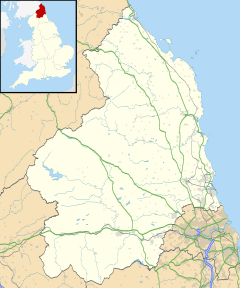Hexhamshire facts for kids
Quick facts for kids Hexhamshire |
|
|---|---|
| Population | 697 (2011) |
| OS grid reference | NY927576 |
| Unitary authority |
|
| Ceremonial county | |
| Region | |
| Country | England |
| Sovereign state | United Kingdom |
| Post town | HEXHAM |
| Postcode district | NE |
| Police | Northumbria |
| Fire | Northumberland |
| Ambulance | North East |
| EU Parliament | North East England |
| UK Parliament |
|
Hexhamshire is a small area in Northern England. It is known today as a civil parish. This means it's a local government area. Hexhamshire became part of Northumberland in the year 1572.
Contents
The History of Hexhamshire
How Hexhamshire Began
Hexhamshire started as one large area around the church of St Andrew, Hexham. Old records from 1295, 1547, and 1608 show that its size stayed the same for a long time.
It was likely formed from land given in 674. This land was a gift to Wilfrid, who was the Bishop of York. The Northumbrian queen Æthelthryth gave him the land. It was meant to support the new Bishopric of Hexham. Since the land was given as one piece, it was probably already a single area.
Changes in Ownership and Power
In 854, the Hexham church area was split. It was divided between the Lindisfarne and York church regions. By 883, the Bishops of Lindisfarne owned Hexhamshire.
The Bishops of Durham, who followed the Lindisfarne bishops, continued to govern Hexhamshire. This lasted through the 1000s. But in 1071, William the Conqueror attacked the North of England. This event was called the Harrying of the North. Bishop Æthelwine had to flee. Uthred, who was in charge of Hexhamshire, then gave control to Thomas of Bayeux. He was the Archbishop of York.
Hexhamshire's Special Status
King Henry I later confirmed that the Archbishop of York owned Hexhamshire. A proper system for running the area was set up.
Hexhamshire was a "royal liberty". This meant it was a special area where the king's usual rules did not fully apply. The Archbishop of York had powers that the king usually held. This included full power over law and administration. He could hold court cases and control business. He also had the only right to collect taxes.
Officials chosen by the archbishop ran the area. These included a bailiff, judges, and a coroner. Royal officials were kept out of Hexhamshire. It stayed independent from the king's legal system throughout the 1200s.
Becoming Part of Northumberland
Until 1572, Hexhamshire was also an independent "county palatine". This was like a small, independent county. Records show that local leaders were called "of the county of Hexham" in the late 1300s.
In 1408, a criminal from Hexhamshire was released by royal judges. They said the crimes happened "outside the county of Northumberland." This showed Hexhamshire was seen as separate. An Act in 1482 even listed Hexhamshire with Cheshire and County Durham. These were places where money from fines did not go to the king.
Hexham Abbey was closed down in 1537. This was part of the Dissolution of the monasteries. After some local rebellions, the Crown took control of Hexhamshire in 1545. Once the king owned it, its special independent status didn't make sense anymore. So, in 1572, it was officially ended.
Hexhamshire became part of Northumberland in 1572. This was done by an Act of Parliament. At the same time, the area moved from the Durham church region to the York church region. It stayed there until 1837.
Hexhamshire Today: The Civil Parish
Today, Hexhamshire is the name of a civil parish. A civil parish is the smallest unit of local government in England. It is located south of Hexham.
The parish covers a large area. However, most of it is not very populated. It includes the villages of Dalton and Whitley Chapel. It also has Broadwell House and Hexhamshire Common.
The current civil parish was formed in 1955. It was created by joining three smaller parishes: Hexhamshire High Quarter, Hexhamshire Middle Quarter, and Hexhamshire West Quarter. Hexhamshire Low Quarter, to the north, joined on April 1, 2011.
See also
- Historic counties of England
- Allertonshire
- Hallamshire
- Howdenshire
- Richmondshire
- Winchcombeshire


